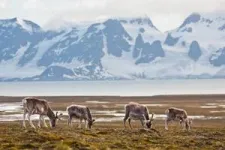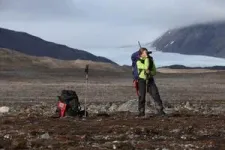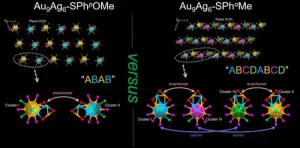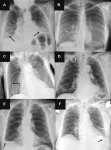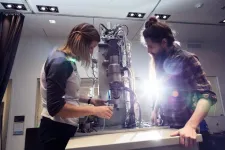(Press-News.org) "Of all the subspecies of reindeer found in the high north, the Svalbard reindeer has the most inbreeding and the lowest genetic diversity," says Nicolas Dussex, a postdoc at Norwegian University of Science and Technology´s (NTNU) Department of Natural History.
It was only 7000-8000 years ago that the first reindeer migrated to Svalbard, most likely from Russia via Novaya Zemlya and the islands of Franz Josef Land. Perhaps there were no more than a few animals that established themselves on the arctic archipelago. Evolutionary theory suggests this is a poor starting point since inbreeding can quickly lead to an accumulation of harmful mutations and genetic variants followed by disease and death.
Rapid adaptation to an extreme environment
But this has not prevented the Svalbard reindeer from evolving into what is today a viable population of more than 20,000 animals.
"Despite the low genetic diversity, they have managed to develop a number of adaptations to life in the High Arctic. They are, for example, smaller in size and have shorter legs than other northern reindeer and caribou subspecies," says Dussex.
The ability to digest mosses in the absence of lichens, and to adjust their circadian rhythm to the extreme seasonal variations on Svalbard, are also traits the Svalbard reindeer have developed over the relatively short time they have lived isolated on the archipelago. Now, researchers at NTNU and collaborating institutions have analyzed genetic samples from 91 reindeer to see how they differ from their relatives on the mainland.
"Populations living on isolated islands are often small and are well-suited studying genetic problems. The Svalbard reindeer has been isolated for at least 7000 years and has a very high degree of inbreeding. In addition, they were nearly extinct in the early 1900s due to excessive hunting," says Michael D. Martin, a professor at NTNU’s Department of Natural History.
Getting rid of harmful mutations
This near-extinction, where only a few individuals with their unique genetic variants survive, is called a bottleneck in population biology.
"In this case, we are dealing with a population that suffers from a high degree of inbreeding, which is usually bad news for a small population. But inbreeding can also help a population to get rid of harmful mutations, a phenomenon technically called 'purging'," says Martin.
In a population with a high degree of inbreeding, offspring are more likely to inherit harmful mutations from both mother and father. Therefore, these "dangerous" mutations more quickly manifest in the form of genetic diseases and poorer health. Offspring carrying these mutations become less "fit", and they will either die before they have the chance to reproduce or they will have fewer offspring. Consequently, these dangerous mutations are less likely to be passed on to subsequent generations.
"Paradoxically, in the long run, inbreeding can be beneficial," says Dussex.
Punctuated evolution or steady and continuous?
Similar phenomena have been observed elsewhere in nature. In New Zealand, Kakapo parrots (Strigops habroptilus), which had lived isolated on the islands for at least 10,000 years, became endangered after the arrival of non-native species brought to the islands by humans. In 1995, there were only 60 individuals left, but today the population has grown to around 200. Here too, Dussex and his colleagues found that harmful genetic variants had disappeared from the population thanks to a long period of inbreeding.
"This is important knowledge when it comes to population management. The fact that the Svalbard reindeer is in relatively good genetic condition considering harmful mutations, is good news," says Brage Bremset Hansen, professor of conservation biology at NTNU's Department of Biology and Center for Biodiversity Dynamics. Hansen is also a senior researcher at the Norwegian Institute for Nature Research (NINA).
This knowledge about the Svalbard reindeer can also change the way researchers study the effects of genetic bottlenecks, Dussex said.
"What we still do not know enough about is how quickly such harmful mutations are selected against. We will continue to work on this, using DNA samples collected from bone remains and antlers of animals that lived several thousand years ago. This way, we can see whether these mutations have disappeared quickly over a few centuries or if it has happened gradually over several thousand years,” he said.
The researchers are also very interested in examining the development of beneficial mutations, which have allowed the Svalbard reindeer to adapt to the unique ecosystem.
"This is a 'work in progress'," says Martin, who also worked closely with researcher Mathilde Le Moullec, who over past years did the fieldwork to collect most of the bone samples from various locations on Svalbard.
Climate change may be too fast
It is far from certain that the Svalbard reindeer will be able to adapt as well to the rapid changes that result from global warming. The adaptations the reindeer have developed for the extreme arctic climate may fall short as the archipelago is now rapidly warming, which is changing both snow cover and vegetation.
"Global warming is causing Svalbard’s climate to change faster than anywhere else in the world. Even though our results show that the Svalbard reindeer managed to adapt relatively quickly to a completely new environment after they colonized the islands, they might have trouble adapting to today's rapid warming. They may have simply lost too much genetic variation," says Hansen.
This also applies to other terrestrial animals that have limited opportunities to move as climate change makes life difficult for them.
"But this work now provides us with a better basis for understanding how quickly species can adapt to new environments," says Martin.
Reference:
Adaptation to the High-Arctic island environment despite long-term reduced genetic variation in Svalbard reindeer. Nicolas Dussex, Ole K. Tørresen, Tom van der Valk et al. iScience VOLUME 26, ISSUE 10, 107811, OCTOBER 20,2023. DOI:10.1016/j.isci.2023.107811
END
Inbreeding can be beneficial in the long run
Reindeer have survived for more than 7000 years on the arctic archipelago of Svalbard. Can they survive climate change?
2023-09-26
ELSE PRESS RELEASES FROM THIS DATE:
Feds fund research that could slash US cancer deaths by 50%
2023-09-26
HOUSTON – (Sept. 26, 2023) – The Advanced Research Projects Agency for Health (ARPA-H) has awarded $45 million to rapidly develop sense-and-respond implant technology that could slash U.S. cancer-related deaths by more than 50%.
The award to a Rice University-led team of researchers from seven states will fast-track development and testing of a new approach to cancer treatment that aims to dramatically improve immunotherapy outcomes for patients with ovarian, pancreatic and other difficult-to-treat cancers.
“Instead of tethering patients to hospital beds, IV bags and external monitors, ...
Thiol ligands modify metal nanocluster structures and optical properties
2023-09-26
Metal nanoclusters are tiny, crystalline structures up to two nanometers (2 x 10-9 meters) in diameter that contain a few to hundreds of metal atoms. Understanding the precise assembly of metal nanoclusters is paramount to determining how different structures affect the properties and molecular interactions of these materials. Researchers recently synthesized two similar gold-silver (Au9Ag6) nanoclusters in a highly controlled manner to determine the precise atomic structure of each nanocluster and the effects of specific thiol ligands, or sulfur-containing binding molecules, on material synthesis.
Given their extremely small size, metal nanoclusters have ...
Researchers build and test a framework for achieving climate resilience across diverse fisheries
2023-09-26
(Santa Barbara, Calif.) — What makes for a successful climate-resilient fishery, one that sustainably produces resources for human benefit despite increasing climate stressors and human impacts? It’s a question that faces present and future fisheries, their practitioners and fishing communities as the world turns to the ocean to feed its growing population.
“For a fishery to be resilient it needs to be able to prepare for, resist, cope with, recover from, or adapt to any given impact,” said Jacob Eurich, who is a research associate at UC Santa Barbara’s Marine Science Institute, and a fisheries scientist at the Environmental Defense Fund (EDF). “In ...
Radiologists outperformed AI in identifying lung diseases on chest X-ray
2023-09-26
OAK BROOK, Ill. – In a study of more than 2,000 chest X-rays, radiologists outperformed AI in accurately identifying the presence and absence of three common lung diseases, according to a study published in Radiology, a journal of the Radiological Society of North America (RSNA).
“Chest radiography is a common diagnostic tool, but significant training and experience is required to interpret exams correctly,” said lead researcher Louis L. Plesner, M.D., resident radiologist and Ph.D. fellow in the Department of Radiology at Herlev and Gentofte Hospital in Copenhagen, Denmark.
While commercially available ...
SwRI, UTSA collaborate to detect traumatic brain injury through breath analysis
2023-09-26
SAN ANTONIO — September 26, 2023—Researchers from Southwest Research Institute (SwRI) and The University of Texas at San Antonio (UTSA) are developing techniques to detect traumatic brain injury (TBI) by analyzing breath for specific biomarkers. The project, led by SwRI’s Dr. Mark Libardoni and UTSA’s Dr. Marzieh Memar and Dr. Morteza Seidi, is supported by a $125,000 grant from the Connecting through Research Partnerships (Connect) program.
Breath analysis is performed by analyzing exhaled breath for specific biomarkers, such as metabolites, proteins and ...
Projects launch to map brain connections in mouse and macaque
2023-09-26
A complete map of all the connections in an entire mammalian brain may be in sight. Allen Institute researchers have just launched three new projects to construct large, detailed maps of neuronal connections in sections of the mouse and macaque brains, with an eye toward creating full wiring diagrams of these animals’ brains in the future. These projects are funded by the National Institutes of Health’s Brain Research Through Advancing Innovative Neurotechnologies® (BRAIN) Initiative.
Allen Institute research teams ...
National Science Foundation research award will expand the shift+OPEN initiative from the MIT Press
2023-09-26
The MIT Press is delighted to announce that it has received a two-year, $275,000 Early-Concept Grant for Exploratory Research (EAGER) from the National Science Foundation to expand the shift+OPEN initiative and shift at least two more journals to diamond open access. The Press will also use the grant to assess and compare the viability of open access models for advancing and sustaining the outputs of scientific and scholarly STEM and HSS research.
“We’re grateful to the National Science Foundation for their support of our growing shift+OPEN program,” says Nick Lindsay, Director for Journals and Open Access for the MIT ...
New report shows Food is Medicine interventions would save U.S. lives and billions of dollars
2023-09-26
Incorporating targeted food and nutrition strategies into healthcare on a national level will improve health and quality of life, reduce work for hospitals, and cut healthcare costs, according to experts studying Food is Medicine (FIM) efforts. The health and economic benefits of this approach are detailed in a report out today from researchers at the Food is Medicine Institute at the Friedman School of Nutrition Science and Policy at Tufts University, through support from The Rockefeller Foundation.
The True Cost of Food: Food is Medicine Case Study quantifies the potential health and economic benefits of FIM efforts, which refer to food-based nutrition ...
The Giant Magellan Telescope’s final mirror fabrication begins
2023-09-26
PASADENA, CA — September 26, 2023 — The Giant Magellan Telescope begins the four-year process to fabricate and polish its seventh and final primary mirror, the last required to complete the telescope’s 368 square meter light collecting surface, the world’s largest and most challenging optics ever produced. Together, the mirrors will collect more light than any other telescope in existence, allowing humanity to unlock the secrets of the Universe by providing detailed chemical analyses of celestial objects and their origin.
Last week, the University of Arizona Richard F. Caris Mirror Lab closed the lid on nearly 20 tons of the ...
Fabrication of p-type 2D single-crystalline transistor arrays with Fermi-level-tuned van der Waals semimetal electrodes
2023-09-26
Professor Soon-Yong Kwon in the Department of Materials Science and Engineering and the Graduate School of Semiconductor Materials and Devices Engineering at UNIST, in collaboration with Professor Zonghoon Lee, has embarked on a pioneering research endeavor focusing on the development of high-performance p-type semiconductor devices, utilizing molybdenum ditelluride (MoTe2)—a compound renowned for its unique properties. This pioneering technology holds great promise for application in the next-generation complementary metal oxide semiconductor (CMOS) industry, where ultrafine technology is crucial.
CMOS ...
LAST 30 PRESS RELEASES:
Victoria’s Secret grant backs cutting-edge ovarian cancer research
Research paves the way for safer colonoscopy bowel prep for people with compromised gut health
JMIR Publications and Sweden's National Library announce renewal and expansion of flat-fee unlimited open access partnership for 2026
A new 3D-printed solar cell that’s transparent and color-tunable
IV iron is the cost-effective treatment for women with iron deficiency anemia and heavy menstrual bleeding
Doing good pays off: Environmentally and socially responsible companies drive value and market efficiency
City of Hope and Cellares to automate manufacturing of solid tumor CAR T cell therapy
Short-circuiting pancreatic cancer
Groundbreaking mapping: how many ghost particles all the Milky Way’s stars send towards Earth
JBNU researchers propose hierarchical porous copper nanosheet-based triboelectric nanogenerators
A high-protein diet can defeat cholera infection
A more accurate way of calculating the value of a healthy year of life
What causes some people’s gut microbes to produce high alcohol levels?
Global study reveals widespread burning of plastic for heating and cooking
MIT study shows pills that communicate from the stomach could improve medication adherence
Searching for the centromere: diversity in pathways key for cell division
Behind nature’s blueprints
Researchers search for why some people’s gut microbes produce high alcohol levels
Researchers find promising new way to boost the immune response to cancer
Coffee as a staining agent substitute in electron microscopy
Revealing the diversity of olfactory receptors in hagfish and its implications for early vertebrate evolution
Development of an ultrasonic sensor capable of cuffless, non-invasive blood pressure measurement
Longer treatment with medications for opioid use disorder is associated with greater probability of survival
Strategy over morality can help conservation campaigns reduce ivory demand, research shows
Rising temperatures reshape microbial carbon cycling during animal carcass decomposition in water
Achieving ultra-low-power explosive jumps via locust bio-hybrid muscle actuators
Plant-derived phenolic acids revive the power of tetracycline against drug-resistant bacteria
Cooperation: A costly affair in bacterial social behaviour?
Viruses in wastewater: Silent drivers of pollution removal and antibiotic resistance
Sub-iethal water disinfection may accelerate the spread of antibiotic resistance
[Press-News.org] Inbreeding can be beneficial in the long runReindeer have survived for more than 7000 years on the arctic archipelago of Svalbard. Can they survive climate change?

